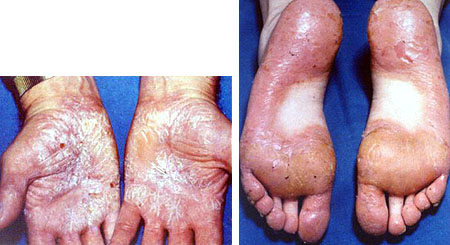Erythrodermic Psoriasis
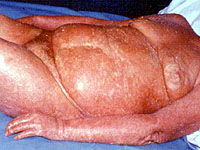 It is uncommon. The entire skin is erythematous and scaly. It can develop spontaneously or can be triggered with treatments such as gold, ultraviolet, penicillin, chloroquine or misusage of local steroids. It appears as an isomorphic response or a drug reaction. The discontinuation of systemic corticosteroid treatment is an example for this situation. There may be severe nail changes. Dermatopathic lymphadenopathy and severe pruritus may be present. It is uncommon. The entire skin is erythematous and scaly. It can develop spontaneously or can be triggered with treatments such as gold, ultraviolet, penicillin, chloroquine or misusage of local steroids. It appears as an isomorphic response or a drug reaction. The discontinuation of systemic corticosteroid treatment is an example for this situation. There may be severe nail changes. Dermatopathic lymphadenopathy and severe pruritus may be present.
Pustular Psoriasis
- Generalized pustular psoriasis (von Zumbusch)
- Psoriasis Vulgaris with pustules
- Pustular psoriasis of the palms and soles (Barber)
Generalized Pustular Psoriasis
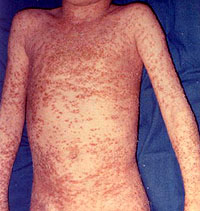 Acute or subacute inflammatory erythema and numereous pustules are present throughout the entire skin. Systemic symptoms such as fever and exhaustion can accompany. Recurrences can be seen. Acute or subacute inflammatory erythema and numereous pustules are present throughout the entire skin. Systemic symptoms such as fever and exhaustion can accompany. Recurrences can be seen.
Psoriasis Vulgaris with Pustules
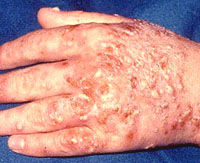 Patients with psoriasis vulgaris may develop inflammatory erythema, exudation, pustules and increased scales as a result of discontinuation of systemic corticosteroids, acute infection, drug reaction, pregnancy or intensive anthralin therapy. Systemic symptoms are absent. Patients with psoriasis vulgaris may develop inflammatory erythema, exudation, pustules and increased scales as a result of discontinuation of systemic corticosteroids, acute infection, drug reaction, pregnancy or intensive anthralin therapy. Systemic symptoms are absent.
Pustular psoriasis of the palms and soles
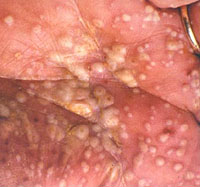 Sharply bordered, flat-topped sterile pustules are limited to the palms and soles. Continuously new pustules appear and old ones dry up and regress. The patients complain of the painful pustules. Systemic symptoms are absent. The course is chronic. Sharply bordered, flat-topped sterile pustules are limited to the palms and soles. Continuously new pustules appear and old ones dry up and regress. The patients complain of the painful pustules. Systemic symptoms are absent. The course is chronic.
Psoriatic Arthritis
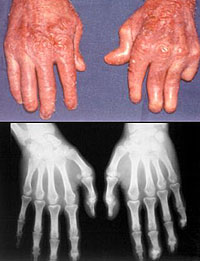 Different patterns of joint involvements can be seen. It is rare. Different patterns of joint involvements can be seen. It is rare.
- Assymetrical oligoarthritis and monoarthritis (30-50%)
- Symmetric polyarthritis, like rheumatoid arthritis (30-50%)
- Axial arthritis, like ankylosing spondilitis (Spondilitis, sacroileitis and/or shoulder or hip arthritis) (5%)
|
